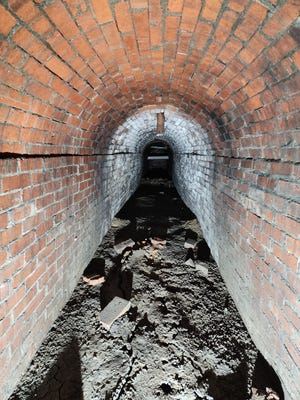[ad_1]
- A tunnel was recently discovered in a Pennsylvania borough that could be part of the Underground Railroad, a historian theorizes.
- Researchers in the area have previously found sites that once served as Underground Railroad destinations.

NEW BRIGHTON, Pa. – A backed-up sewer led to a surprising discovery of historical significance in Pennsylvania.
Turns out, a brick tunnel had been hidden since the 1800s under the Merrick Art Gallery in New Brighton.
“We are not positive, but we do think it may be related to the Underground Railroad,” said Michelle Long, director of the Merrick Art Gallery. “We’d have to prove it a bit more, but in my heart and mind there’s a connection.”
New Brighton historians have, after all, previously documented several locations in the borough that served as Underground Railroad destinations helping slaves find freedom prior to the Civil War.
Underground Railroad: Erie man discovers early Underground Railroad station and once-enslaved couple who ran it
Black History: The pathways of African American history stretch across the US
This Sept. 30, the New Brighton Historical Society’s annual guided Underground Railroad tour will visit borough sites like the Irish-Townsend House built in 1855 for abolitionist and Underground Railroad conductor Lydia Irish.
Another tour stop is the James Edgar house, built in 1849 and used as an inn and livery by Presbyterian Abolitionist James Edgar. Folklore has long held the two-story brick Edgar house was connected by tunnel to the Erie-Pittsburgh Railroad, at a spot that’s now the site of the Merrick Art Gallery.
“At this stop, fugitives often dressed as Underground Railroad conductors’ servants were secretly led through the tunnel to Edgar’s cellar and then transferred to an available ‘safe house,'” reads the Edgar House’s historical sign commissioned after extensive research by the New Brighton Historical Society.

The tunnel discovered under the Merrick confirms that folklore, Mike Spratt of the New Brighton Historical Society said.
Insurance documents from the mid-19th century prove Edgar owned a stable on the site where the tunnel likely reached.
The tunnel traverses underneath the Merrick, a circa 1850 brick and iron structure that showcases French, German, English and American paintings from the 18th and 19th centuries.
Sewer issue led to discovery
The tunnel’s discovery resulted after The Merrick, listed on the National Register of Historic Places, encountered sewer line problems a week ago.
Museum officials hired Debo & Son Excavating to replace the sewer line. With the ground dug up, a Debo employee mentioned working for a different company at that same Merrick site about 40 years ago when the gallery was putting in a kitchen and new bathrooms. He said employees then discovered a tunnel, and reported their finding to a museum representative, but were told to refill the dirt. No formal historic inquiry was conducted, according to Long.

For Long, who became director of the Merrick in January 2021, that tunnel tip was too intriguing to ignore. Especially since it coincided with a recent discovery by her husband Jim Long, the Merrick’s volunteer handyman, of old blueprints of the Merrick showing what looked like an underground tunnel on the property.

Long was determined to find answers.
“So, after they were done with the sewer project, we started digging where we felt it might be,” Long said.
Volunteers only needed to dig a small hole a few feet below an area between the Merrick’s garden and patio before hitting the top of an underground tunnel.

After a few more days of digging, they found the opening to the 5-foot-tall tunnel. Determining it was structurally sound enough, Long’s son-in-law explored the tunnel, learning it reaches a length of about 150 feet, traversing below the Merrick, before coming to a bricked-off ending under the sidewalk of present-day Fifth Avenue.
The western opening of the tunnel is now exposed and within inches of a short hedgerow in the Merrick’s lush garden grounds.
“There was a church back there at one time, and the foundation of that church would have butted up against the tunnel,” Long said. “So, it seems pretty convincing.”
Blueprints discoverer Jim Long theorizes the tunnel had been built by the public railroad, perhaps as an area for trains to release steam before pulling to a stop at the New Brighton station, which from roughly 1850 to 1870 stood next to the original Merrick structure that later expanded to take over the entire property to Fifth Avenue.
Spratt, too, wonders what the tunnel’s original purpose was, “but it probably did help runaways.”

Could that former church have provided an entrance to the tunnel, connecting it to the Edgar House, which historians have established was a safe house on the Underground Railroad?
“I plan to get to the bottom of it,” Long said.
She’s already planning to improve the landscaping and add a protective iron gate to the tunnel’s entrance, so Merrick visitors can get a close-up look and snap photos.
Scott Tady is entertainment editor at The Times and easy to reach at stady@gannett.com.
[ad_2]
Source link





